Tennis elbow is a form of tendinosis which means chronic degeneration of the tendon or tendons. You will have tenderness on and around the tendons that attach to the small bony part on the outside of your elbow (lateral epicondyle), and perhaps a bit of swelling but not much. Tennis Elbow tendinosis is commonly caused from the overuse of the tendons located in your forearm that help to extend your wrist and fingers. The wear and tear on these tendons is a result of small tears in your tissue that don't heal properly. The inability of your tendon to heal properly causes the tendons to weaken until the tissues become very thin, and eventually wear out.
Tendinosis will get worse over time if not dealt with properly. Your body is trying very hard to heal the damaged tissue. This cycle of pain, swelling and unhealing causes tennis elbow to go on for a very long period of time (ie. years). Why? Failed healing, not inflammation; if you cannot rest the elbow while you are healing then your odds of healing it for good are quite low.
Tennis elbow can affect anyone. In 75% of cases, tennis elbow occurs on your dominant arm. It affects about an equal number of men and women, generally between the ages of 35-65 years old.
(source: NCBI U.S. National Library of Medicine)
Tendonosis is a noninflammatory, degenerative condition of the collagen fibers in the tendon often caused by repetitive stress injury of the tendon fibers. As the collagen breaks down, the typically straight and flexible fibers become a tangled mess with little pockets of jelly.
Tendonosis is caused by repetitive motion which causes an accumulation of microinjuries. The tendon tries to repair itself but eventually the breakdown of the collagen fibers exceeds the repair speed and the new collagen is produced with an abnormal structure and composition.
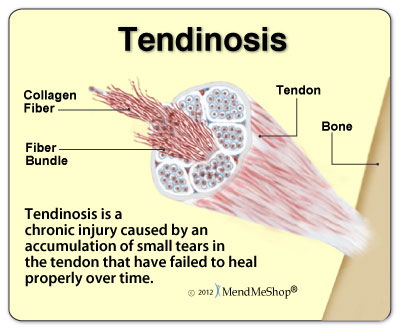
Unlike tendonitis, there are no inflammatory tissues with a tendonosis injury making it hard to diagnose visually as there are no visible symptoms such as swelling, heat and redness. However, both injuries cause pain, tenderness and stiffness of the joints.
If not treated correctly the tendon will continue to degenerate causing further injury.
Visiting your doctor when you have elbow pain is always recommended, as there are many possible issues that can happen within the arm and elbow. Sometimes, one set of symptoms can result in multiple diagnoses. Tennis elbow is sometimes misdiagnosed as bursitis or arthritis. A few conditions that may show symptoms similar to Tennis Elbow are as follows..
The closer the bursa is to the surface of the skin, the more likely the chance of infection from specific bacteria that are commonly found on the surface of the skin. This bacterial infection is known as septic bursitis and it is caused by the Staphylococcus Epidermis (or Staphylococcus Aureus) bacteria. Septic Bursitis occurs most commonly in men (85% of all cases occur in men) and you are at higher risk of contracting this if you:
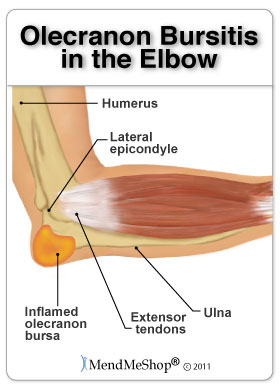
Some people with diseases such as rheumatoid arthritis, gout or scleroderma may contract bursitis from crystalline deposits in the joints. Although not much is known about how this process happens, it is common knowledge that Uric acid is a normal byproduct of daily metabolism. If you are diagnosed with gout then you are unable to break down this uric acid properly, leading to crystallization of this excess acid which deposits in joints, a painful symptom that can often lead to bursitis.
Golfer's Elbow is signified by pain, swelling and inflammation that is felt on the inside of the elbow. The tendons attached to the bone at your elbow are connected to muscles in your forearm, which is why these injuries will sometimes cause pain in your forearm. These injuries are usually caused by racquet sports, golf and overuse from gardening and repetitive movements of your hand or wrist (ie. using a screwdriver).
The onset of tennis elbow pain is normally gradual with tenderness or a dull ache felt in the tendons of your forearm muscles on or below the bony bumps of your elbow.
Pain can also be experienced when your wrist or hand are straightened, when your palms are facing the ceiling, when you flex your wrist and fingers backwards while straightening your elbow, or when you rest your wrists on a tabletop or desk.
Are you noticing pain, discomfort, immobility or restricted motion in your elbow or forearm? Do these symptoms appear before, during, or after you exercise, do daily household duties, or at work? These symptoms could be the first sign that you are suffering from Tennis Elbow.
You may notice swelling, heat or redness, inability to lift or carry objects, inflexibility, deformation, bruising, or pain caused by movement or that persists even through rest. If you have tennis elbow, you will feel pain or discomfort when performing repetitive movements such as grasping, carrying objects (a tray, a baby or books), or twisting with your hands or wrists.
If you do not seek treatment in the form of warming and cooling temperature treatments for your symptoms and you are suffering from Tennis Elbow, you may develop a chronic Tennis Elbow injury due to overuse or even re-injury.
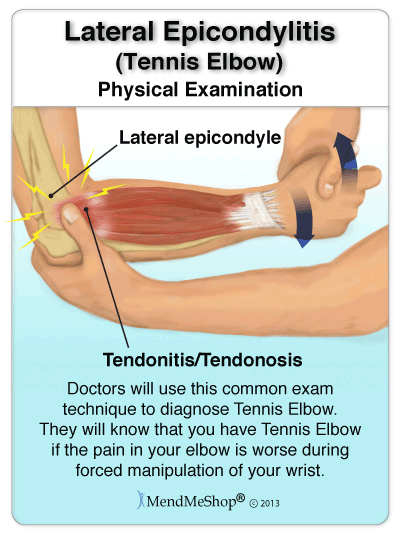
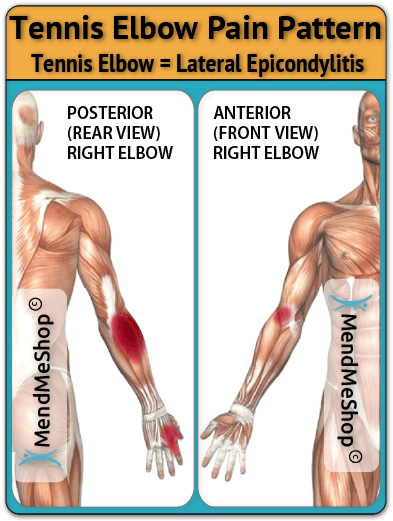
Chronic symptoms can include pain before, after, and during activities that does not go away as well as limited range of motion and inflexibility that will interrupt your daily life. Straightening your wrist or hand, or turning your palms to face the ceiling may cause severe discomfort. Extending and flexing your fingers or lifting everyday objects can trigger Tennis Elbow pain. These symptoms may require you to change, or completely stop, movements using your arm or hand.
In severe cases, turning a screwdriver or even holding a coffee cup can cause intense discomfort. It is easy to forget how much you use your hands and arms on a daily basis. When you are suffering from Tennis Elbow, even the most simple tasks can become quite a challenge!
Imagine having to take weeks or even months off work, or missing a whole season of your favorite sport or activity. The burden that an untreated Tennis Elbow injury can place on your finances, your family, and your quality of life, can be heavy.
Tennis Elbow pain normally starts with tenderness or a dull ache around the bony bumps on the outside of your elbow. These bumps are also known as your lateral epicondyle bone. It is here, that the tendon for the muscle in your forearm, attaches to the bone. If left untreated, the pain may gradually start to radiate, from the outside of your elbow, extending down into your forearm and wrist. Typically tennis elbow starts off as acute, or short lived pain that goes away after about 24 hrs.
Symptoms of Tennis Elbow are not the same for everyone. You may experience only one symptom or perhaps a combination of symptoms. The severity of these symptoms can differ from person to person.
Sometimes, a person suffering from Bi-lateral Tennis Elbow (that's both elbows at once ) will have different symptoms for each elbow. This is because no two injuries are exactly the same.
You may notice slight discomfort in your elbow, that disappears after a few hours or up to a day later. If you are relying on short periods of rest or use Non-Steroidal Anti-Inflammatory Drugs (NSAIDs) to mask the pain of your injury, you are not giving your body the proper attention it needs to recover.
In fact, by masking your symptoms of pain, immobility, and discomfort, you are blocking out the warning signs your body is using to tell you something is wrong!
By hiding your Tennis Elbow symptoms you are putting yourself at risk for damaging your elbow permanently.

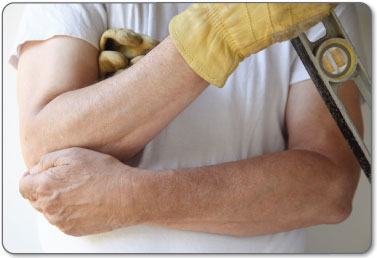
While some symptoms can occur suddenly (as with an accident or acute trauma), Tennis Elbow is most often a case of gradual overuse. If not given proper attention, repetitive stress and re-injury will develop into a Chronic Tennis Elbow Injury.
It is important to remember that pain is not the only indication of a serious injury. The micro tears, scarring, and inflammation (which are the underlying causes of Tennis Elbow) can occur even if pain is not noticeable or is relieved quickly. Injury due to repetitive stress are most often caused by this common misunderstanding. Short term pain relief such as rest, elevation, and medication will help initially, but it does not promote long term healing
Being proactive is the best way to fight Tennis Elbow. Stop the pain and damage before it causes further injury requiring months, or even years of your life spent in recovery. The information you will discover here will help you manage your Tennis Elbow symptoms as soon as possible.
Talk to your physician about using cooling and warming temperature treatments to transform short term pain relief into long term recovery and sustainable results. Cold Therapy and Circulation Boost (via use of the Elbow TShellz Wrap®) will treat symptoms and minimize the damaging effects that daily, work related, or recreational activities can cause to an already injured, elbow.
The 3 main events that cause tennis elbow. Although over 50% of tennis players will experience tennis elbow at some point in time, it is caused by many common activities. It generally affects men and women between 35-65 years of age who stress their wrist and elbow through twisting or extending motions in repetitive work or activities. This condition is very common with sports participants (racquet sports, golfers, fencers, swimmers, throwing sports) as well as plumbers, carpenters, landscapers, painters, waitresses, librarians, office workers and musicians.
Tennis elbow typically results from vigorous use and movements of the wrist, arm or hand over via overuse or via overstraining. The affected soft tissue are forearm muscles that move your fingers, hand, wrist and forearm and their corresponding tendons. Overuse of these muscles depends on how long you do something and how much effort you exert doing it. The constant tugging at the point of attachment on the outside of your elbow (lateral epicondyle) can cause these tendons to become inflamed and strained.
Your muscles and tendons can then become irritated which will result in weaker tendons, tiny tendon tears and development of scar tissue and/or calcium deposits. The development of scar tissue will put pressure on your soft tissue and nerves, and interrupt the blood flow to this area. Scar tissue is tough to get rid of and can cause significant pain over a long period of time. Fortunately, Circulation Boost treatments aid in the reduction of scar tissue and when combined with PT and a conservative treatment plan, most patients can rid themselves of epicondylitis and get back to a normal pain free lifestyle faster than would ever expect.
There can be different factors leading to a re-injury of your lateral epicondyle, but in most cases, the strongest reasons are:
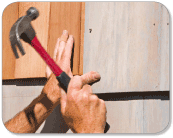
Activities - If your household, workplace, or recreational activities involve significant repetitive movement of your wrist, forearm, upper arm, and/or shoulder you are at risk for developing Tennis Elbow. Some common activities that can cause Tennis Elbow include but are not limited to: painting, house cleaning, playing an instrument, playing sports, heavy lifting, frequent use of a computer (or typing), shaking hands frequently, and/or frequent holding of a phone to the ear
As you can see, its not just professional athletes or people with physically demanding jobs who suffer from Tennis Elbow.
Actively moving your arm for long periods of time can cause a lot of stress to be exerted on your elbow. Repeated movements gradually increases the stress placed on muscles.If you don't give your body a chance to rest and regain strength, stronger muscles ( like the ones in your shoulder )have no choice but to transfer energy to less capable structures (such as the muscles in your hand or wrist ). Weaker muscles cannot handle the impact stronger muscles can. As a result, they begin to strain and even tear.
It is important that you allow your body to rest between periods of exertion or repetitive movement. Fatigue in your muscles can lead to bad form, or overuse. You body is an amazing thing! It is constantly trying to heal itself and perform at its fullest capabilities. When you don't allow your body to rest and push yourself beyond your physical limitations, chances of becoming injured are quite high.
Your tendons attach your forearm muscles to the bone of your elbow. When high levels of stress are exerted on your forearm, tendon fibres stretch beyond their limits. If this action is repeated over and over again, tendon fibers lose their strength and elasticity. They can become disorganized and tangled. If repeated long enough or with too much stress exerted, your tendon fibres may even begin to tear.
These small tears cause inflammation in the area of your elbow called the epicondyle ( the bony bumps just below your elbow where the tendon attaches the forearm muscles to your elbow bone ). You elbow may become swollen, bruised, or disfigured. Your elbow joint is a very small complex structure and doesn't handle swelling well. Swelling will limit blood flow. Micro tears and swelling can cause mild discomfort to intense pain. The limited blood flow can restrict your body's ability to heal. If not treated, your tendon will begin to deteriorate. It can take months for you to fully recover.
If you repeatedly injure your tendon without proper treatment and recovery, scar tissue will form. Scar tissue is weak and inflexible tissue that hardens around the tendon without giving it any support or strength. Scar tissue will never heal into healthy, mature, strong tissue. Scar tissue will put pressure on your soft tissues and nerves. It interrupts the blood flow to the areas of your elbow causing pain and delaying recovery. It is important to prevent the growth of scar tissue with conservative treatments.
This is why it is very important to seek medical advice when you've had an accident or injury. Your doctor will be able to recommend the best course of action for treating your injury using cooling and heating treatments. Incorporating Circulation Boost (via use of an Elbow TShellz Wrap®) will increase your body's ability to heal faster (and thereby reduce growth of scar tissue) by promoting significantly higher flow of blood to your elbow or forearm injury.

If you have read a few pages on this website, you probably know that Tennis Elbow is all about tendons - damaged extensor tendons that attached to the lateral epicondyle to be exact. So when we talk about aging and its effects on Tennis Elbow, we are really talking about the effect that age has on tendons in the forearm.
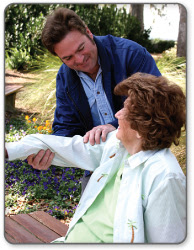
Age is always a factor when it comes to injury. As we become older, our tendons begin to weaken and eventually break down. By not actively participating in exercise and physical activity, the degradation of soft tissue (tendons, ligaments, muscles) accelerates. However, an accelerated breakdown of soft tissue will also occur in individuals that overuse their tendons/muscles - meaning the soft tissue is stressed yet not allowing enough resting time to heal before they are used again.
Over time, repeated damage to your tendon can cause you to develop a condition called 'Tendinosis'. This means that your tendon becomes unable to ever heal fully. Age and repeated injury without proper treatment can cause the breakdown of your tendon.
You should always consult your doctor when you begin to experience recurring pain or symptoms of Tennis Elbow injury. It is essential to speak with a medical professional if you have started, regularly taking, "over the counter" medications to treat your symptoms.
We always recommend that you speak with your physician to confirm the nature and severity of your elbow injury. Continued discomfort in your elbow should be investigated, as it can lead to long term damage. If you experience any of the symptoms below then talk to your physician and see if our conservative treatments are right for you.
If you are experiencing any of the following symptoms, you should speak with your physician as soon as possible. Common Symptoms of Lateral Epicondylitis (Tennis Elbow) are as follows:
NSAIDs can be used if required to help manage your pain. However, these aren't recommended for long term use, as they can cause gastrointestinal difficulties.
Some health professionals also recommend natural supplements such as Glucosamine, MSM or Hyaluronic Acid to help strengthen the injured tissue.
The use of the TShellz Wrap® in conjunction with NSAIDs can greatly improve the effect of this medication and can help to heal your elbow quicker.
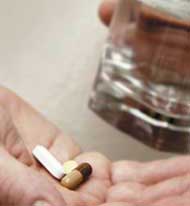
PT is a beneficial way to help decrease pain in the soft tissue, restore atrophied muscles and improve elbow, forearm and wrist strength and mobility. The type of PT and the duration will be dependent on the extent of your injury.
Once your pain starts to diminish, a physiotherapist will also set up an individualized arm and shoulder strengthening and stretching exercise program for you to perform at home or in the gym.
This will be based on your needs and abilities, and will help you return to performing your normal routines.
A trained therapist will help to ensure your rehabilitation process is effective. For best, long term results use the TShellz Wrap® before undergoing PT to gain residual elongation and extensibility of collagen tissue (reference: Chapter 9 of "Therapeutic Heat and Cold", 4th edition. (amazon.com link Ed. Justus F. Lehmann, M.D., Williams, and Wilkin)
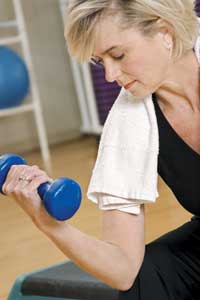
Once you return to your activities, it is beneficial for you to evaluate how you use your arm in these activities to determine if you can decrease stress on the injured tissue. This may involve changing your technique, for example using a two-handed backhand instead of a one-handed backhand in tennis, which will take stress off your forearm muscles. Or, it could also mean implementing ergonomically correct practices, structures and equipment to help you perform tasks more effectively and safely, such as using a properly weighted racquet, or taking more frequent short breaks at work to rest your wrist when using a hammer or screwdriver.
Speak with a professional in the specific activity or work setting to ensure you are using correct procedures and tools.
To learn more about Tennis Elbow , please go to our tennis elbow website here (aidmytenniselbow.com).
Product Advisors are available 9:00 am to 5:00 pm Eastern Standard Time Monday to Friday.
I want to learn more about Post-Surgery Recovery
I want to learn more about TShellz Wrap® Circulatory Boost
I want to learn more about Ice & Heat: Which Is Better For Treatment?
I want to learn more about Tendonitis Treatments
I want to learn more about Tendonitis Surgery
During your recovery, you will probably have to modify and/or eliminate any activities that cause pain or discomfort at the location of your soft tissue injury until the pain and inflammation settle. The more diligent you are with your treatment and rehabilitation, the faster you will see successful results!
Please be aware that this information is neither intended nor implied to be a substitute for professional medical advice. CALL YOUR HEALTHCARE PROVIDER IMMEDIATELY IF YOU THINK YOU MAY HAVE A MEDICAL EMERGENCY. Always seek the advice of your physician or other qualified health provider before using any of our outstanding products to make sure they are right for you and your condition or if you have any questions regarding a medical condition. Always see your doctor for a proper diagnosis as there are often many injuries and conditions (some very serious) that could be the cause of your pain.
© 2025 In.Genu Design Group, Inc. Contact Us